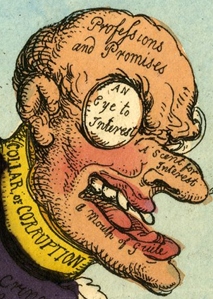All 1 entries tagged China
View all 62 entries tagged China on Warwick Blogs | View entries tagged China at Technorati | There are no images tagged China on this blog
October 02, 2014
GSK's Fine for Corruption
On 19 Sept 2014 the British pharmaceutical giant GSK was fined almost £300m by a Chinese court for bribery of non-government personnel (ie doctors) to use its products. This is the largest fine levied on a company in China. The head of the company’s China operations, Mark Reilly, was given a three year suspended prison sentence. The Chinese authorities alleged that bribery was ‘a core part of the activities of the company. To boost their share prices and sales, the company performed illegal actions’ [ http://www.theguardian.com/business/2013/jul/15/glaxosmithkline-china-bribery-allegations ]

The story of British companies being accused of bribery in Asia is nevertheless not a new one. In the eighteenth century members of the East India Company were also accused of corruption. Merchants returning to Britain having made a quick fortune in India were known as ‘nabobs’, an anglicisation of ‘nawab’, meaning prince. In 1787 one of the nabobs, Warren Hastings, who was called ‘the Captain of Iniquity’ by leading prosecutor Edmund Burke, was indicted by the British Parliament for bribery and corruption. The trial lasted seven years.
The charges against Hastings were, like the ones against GSK, designed to show that corruption was a core part of the East India Company’s activities. He was accused of accepting bribes or ‘presents’ from Indian princes; of handing out corrupt contracts (including for opium, which was sold to China); and of selling offices. In many ways Hastings personified a wider problem of endemic corruption in the East India Company. Like GSK, the Company’s share price was affected by its fortunes in Asia, and Hastings did all he could to promote the Company’s as well as his own interests.
Yet in 1795, in contrast to the recent verdict in China, Hastings was found ‘not guilty’ of the charges against him. In the eighteenth century, the dividing line between a ‘present’ and a bribe was an ambiguous one – this problem was all too apparent in Britain but was magnified in an India context because of a culture of gift-giving. Fostering a good economic network by cultivating social interactions was part of the merchants’ lives, creating muddy lines between personal interests and the interests of the company.
The eighteenth century East India men thought that a present was not necessarily a bribe that distorted how they behaved. George Vansittart, for example, wrote that ‘some presents I have certainly received but you will never hear of my bargaining for them or being influenced by them’ and he thought the same could be said of Hastings: ‘I would not say that Mr Hastings never has received presents but I think I can safely answer for his never having placed his private interest in competition with the publick advantage’. Another nabob was even more defiant: Richard Barwell protested in 1775: ‘I do not pretend …to say I never received a present, but I am certain I can defy any person to charge such to me as a crime’. This old notion of the defensibility of presents – that gifts did not necessarily corrupt - may still persist today.
One other thought is provoked by the GSK affair. The prosecution for bribery was, as GSK’s statement makes clear, ‘of non-government personnel’ (though how far Chinese doctors were non-governmental remains unclear). A common definition of bribery, used by the World Bank and others, is ‘the abuse of public office for private gain’. Here, however, the abuse seems to have been by a commercial company, and the Chinese state has gone after the corrupter rather than corrupted. In other words, the case challenges the economists’ definition of what corruption is and who should be prosecuted for it.
Image caption: Hastings was also accused of offering ‘presents’ to the royal court in order to secure favour during his prosecution for corruption.
 Mark Knights
Mark Knights

 Please wait - comments are loading
Please wait - comments are loading

 Loading…
Loading…

